Why Red Kite Birds Are Rarely Seen Across the USA
Introduction to the Red Kite Bird

Red Kite Birds is a striking raptor that has gained admiration from birdwatchers and conservationists worldwide. With its reddish-brown plumage, forked tail, and elegant flight, it captures attention immediately across open landscapes. Known for soaring gracefully in wide circles, it demonstrates aerial skills that make it stand out among other birds. Originally widespread across Europe, the species faced population declines but has seen remarkable recovery due to conservation programs. In many regions, reintroduction projects successfully restored balance, allowing people to once again appreciate their beauty overhead. Observers often describe its call as a distinctive whistle, easily recognizable even from long distances outdoors. Its adaptability allows survival in farmland, woodland edges, and even suburban areas, where it searches continuously for food sources. The resurgence of these birds is an inspiring example of how conservation efforts can restore balance within ecosystems.
Red Kite Birds Physical Appearance and Unique Traits

One of the most distinctive features of the Red Kite Bird is its forked tail, enabling precise flight maneuverability. This remarkable adaptation allows it to glide effortlessly while scanning landscapes for prey or scavenging opportunities. Its feathers display a stunning mix of red, brown, and white patterns, making identification relatively easy for bird enthusiasts. The sharp eyes of this species help it detect movements far below, often spotting potential food instantly. Compared to other raptors, its wingspan is impressive, contributing to its graceful flight across large expanses of countryside. Unlike some aggressive raptors, the Red Kite prefers scavenging for carrion, although it hunts small mammals and birds occasionally. This behavior plays an important ecological role by cleaning up remains that might otherwise attract harmful pests. These unique traits ensure the bird remains one of the most admired raptors across diverse environments worldwide.
Habitat and Feeding Behavior

The Red Kite Bird typically inhabits open countryside, farmlands, and mixed woodland areas, where visibility and foraging opportunities abound. It avoids dense forests, instead preferring landscapes where it can soar effortlessly while scanning for food. Its diet includes carrion, earthworms, insects, and small vertebrates, demonstrating flexible feeding strategies suitable for varied environments. Farmers often observe kites gliding above plowed fields, searching for exposed worms or small animals left vulnerable. This opportunistic approach highlights adaptability and ensures survival even when food resources become scarce due to seasonal changes. Unlike solitary hunters, these birds sometimes gather in small groups, feeding communally where food availability is relatively high. Their scavenging habits make them ecologically valuable by removing carcasses, reducing risks of disease spreading within ecosystems. By thriving across both rural and semi-urban settings, they showcase resilience as successful survivors in diverse landscapes.
Social Behavior and Intelligence
Red Kites are social birds, often gathering in groups during roosting or communal feeding, especially throughout winter months. These gatherings may include dozens of individuals, creating spectacular aerial displays for observers fortunate enough to witness them. The Red Kite Bird demonstrates intelligence through problem-solving skills, adaptability, and strong communication using whistles, calls, and body language. They are known for playful flight behavior, sometimes carrying sticks or leaves purely for amusement during soaring activities. This playful nature not only reflects intelligence but also creates fascinating moments for birdwatchers observing them in flight. Mating pairs display loyalty, often forming long-term bonds and reusing nests across multiple breeding seasons within familiar territories. Their cooperative behavior, both in feeding and in defending territories, highlights their ability to thrive as social raptors. Such intelligence and community-driven habits ensure their continuing success and survival within both natural and human-dominated environments worldwide.
Conservation Importance and Human Interaction
The Red Kite Bird was once driven close to extinction due to persecution, poisoning, and significant habitat loss. However, thanks to determined conservation projects, populations have rebounded, particularly across parts of Europe and the United Kingdom. These successful reintroductions highlight the importance of public awareness, community support, and strict protective measures for wildlife survival. Today, the bird symbolizes resilience and conservation success, admired not only for its beauty but also its survival story. Human communities have embraced its presence, often organizing feeding stations and supporting efforts to maintain healthy breeding populations. Such actions benefit ecosystems by reinforcing the balance between scavengers, predators, and prey across various interconnected environments. Education campaigns continue reminding people about the significance of protecting birds of prey and maintaining balanced ecosystems. By appreciating and protecting the Red Kite, humanity ensures these magnificent birds remain visible across skies for generations.
 Birds Drawing Birds Drawing
Birds Drawing Birds Drawing




